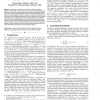Free Online Productivity Tools
i2Speak
i2Symbol
i2OCR
iTex2Img
iWeb2Print
iWeb2Shot
i2Type
iPdf2Split
iPdf2Merge
i2Bopomofo
i2Arabic
i2Style
i2Image
i2PDF
iLatex2Rtf
Sci2ools
PAMI
2002
2002
Performance Evaluation of Some Clustering Algorithms and Validity Indices
In this article, we evaluate the performance of three clustering algorithms, hard K-Means, single linkage, and a simulated annealing (SA) based technique, in conjunction with four cluster validity indices, namely Davies-Bouldin index, Dunn's index, Calinski-Harabasz index, and a recently developed index I. Based on a relation between the index I and the Dunn's index, a lower bound of the value of the former is theoretically estimated in order to get unique hard K-partition when the data set has distinct substructures. The effectiveness of the different validity indices and clustering methods in automatically evolving the appropriate number of clusters is demonstrated experimentally for both artificial and real-life data sets with the number of clusters varying from two to ten. Once the appropriate number of clusters is determined, the SA-based clustering technique is used for proper partitioning of the data into the said number of clusters.
Related Content
| Added | 23 Dec 2010 |
| Updated | 23 Dec 2010 |
| Type | Journal |
| Year | 2002 |
| Where | PAMI |
| Authors | Ujjwal Maulik, Sanghamitra Bandyopadhyay |
Comments (0)

